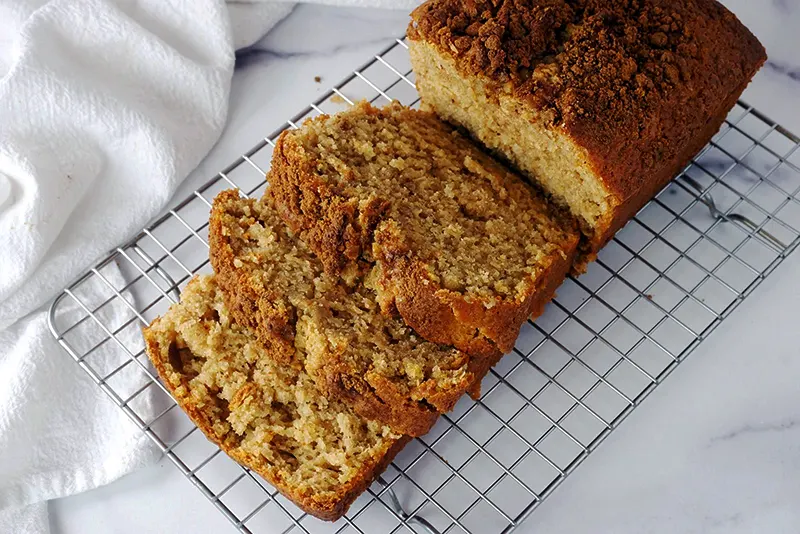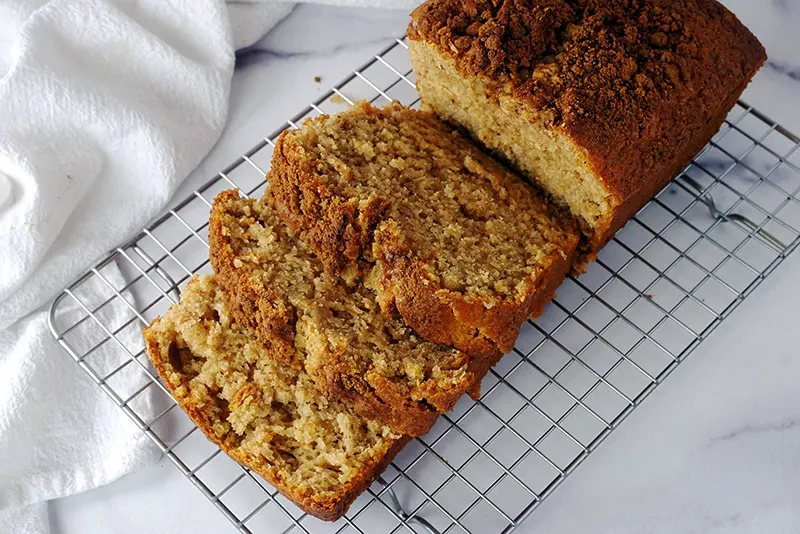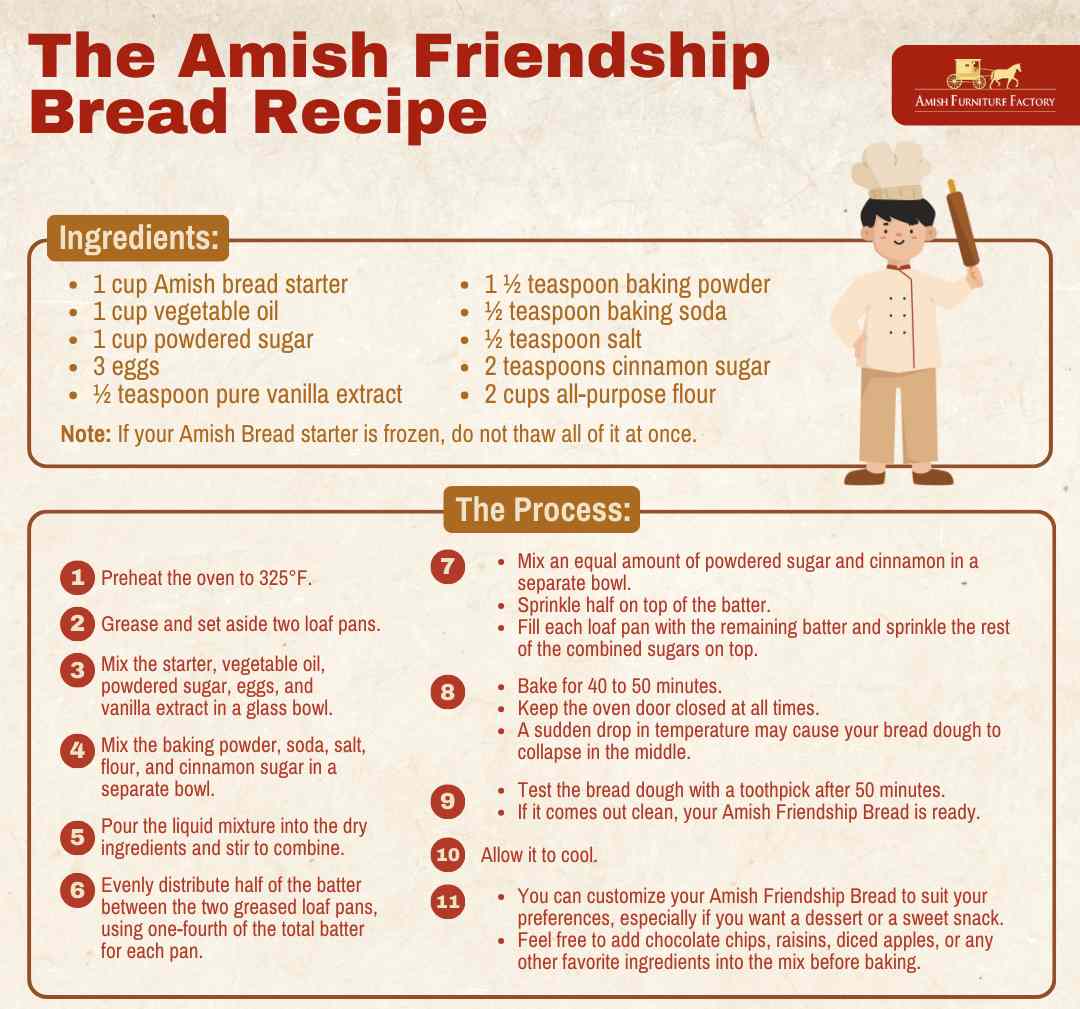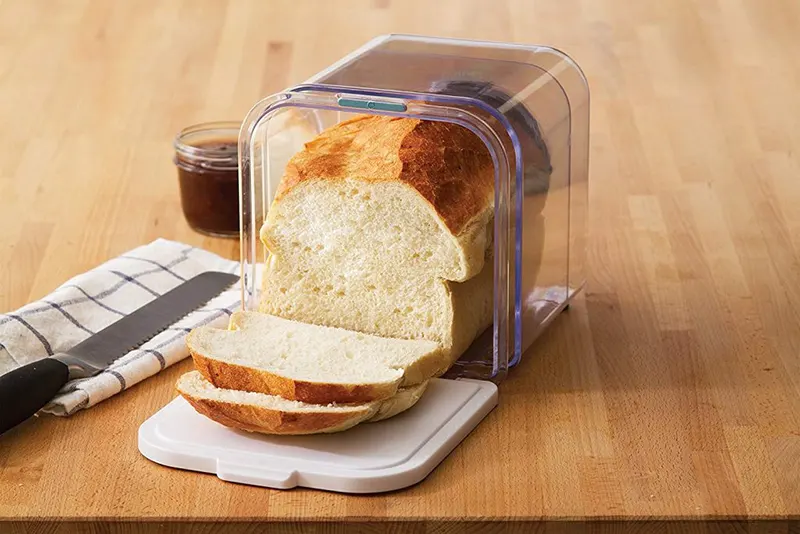The Amish live in tight-knit communities. Their lives center on their church, home, and families. They even share unique values and traditions, including the Amish Friendship Bread.
Key Takeaways:
- – Amish Friendship Bread is a unique type of sourdough bread that embodies the Amish community’s values of simplicity, generosity, and interconnectedness.
- – At the heart of Amish Friendship Bread is the starter, a blend of yeast, flour, sugar, and milk shared among the community.
- – Over the years, bakers have developed countless variations, incorporating fruits, spices, and other ingredients.
If you’ve ever longed for a baking project that blends tradition, community, and a bit of fermenting magic, then you’re in the right place. Below is a handy guide on making the Amish Friendship Bread, along with its history and variations.
The Amish Friendship Bread Tradition
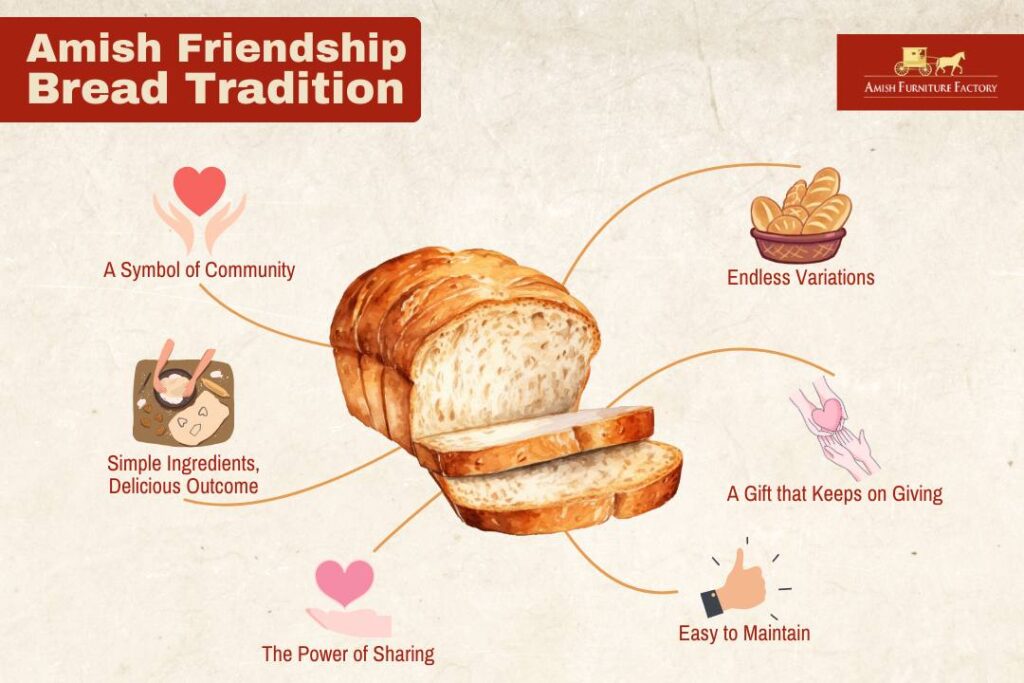
The Amish are a special Christian group recognized for their close-knit communities, simple living, and independence. These values influence everything they do, including their approach to Amish food and cooking. The tradition of Amish Friendship Bread highlights their fundamental beliefs.
Being Amish fundamentally involves embracing “Gemeinschaft,” which means “community” in German. A book about Rural Sociology by Donald B. Kraybill, an expert on Amish culture, highlights this.
Amish communities emphasize helping each other and working together, as shown by activities like barn raisings. The practice of Amish Friendship Bread, where people share the bread’s starter mix, reflects this community spirit, encouraging a sense of togetherness and giving.
The History of The Amish Friendship Bread
The history of Amish Friendship Bread carries with it an aura of mystery, with its true origins shrouded in the mists of time. Commonly known as Amish Cinnamon Bread, its main ingredient, cinnamon sugar, gives it a taste similar to pound and coffee cakes.
While the recipe began making its rounds in newspapers during the early 1980s and later found its way onto the digital landscape in the early 1990s, its roots delve much deeper, reaching back several decades prior to these documented appearances.
Though its precise origin remains unclear, the history of Amish Friendship Bread bears striking resemblance to that of the Herman Friendship Cake, also known as German Friendship Cake, originating from across the Atlantic in Europe. This similarity highlights a shared tradition of generosity and camaraderie, where starters are freely exchanged, enabling more members of the community to partake in the joy of baking and savoring homemade bread.
In her work “The Amish Cook,” Elizabeth Coblentz, a member of the Old Order Amish, sheds light on the genuine essence of Amish Friendship Bread. She reveals that at its core, this bread is essentially a form of sourdough bread, traditionally shared amongst the Amish as a gesture of care and solidarity, particularly with those who are unwell or facing adversity. Indeed, it holds a revered place on Amish family tables, symbolizing the cherished bonds of community and kinship.
Back in the old days, when Amish families baked Amish Friendship Bread, they did it in their simple kitchens. They didn’t have fancy stuff like we do today. They used basic ovens made of bricks or ones that ran on wood. This was because the Amish believe in keeping things simple and doing things for themselves.
Historically, the baking process likely involved the use of simple, traditional ovens such as brick or wood-fired ones, reflecting the Amish commitment to simplicity and self-sufficiency. These ovens, though rudimentary by today’s standards, imbue the bread with a distinct, rustic flavor that speaks to its heritage and the time-honored techniques passed down through generations.
Making the Amish Friendship Bread Starter From Scratch
What makes Amish Friendship Bread unique is its starter, which people commonly share. With just one cup of this starter, you can bake several loaves of bread. You can make this starter anywhere, anytime, using just four ingredients: yeast (either active dry or instant), all-purpose flour, sugar or honey, and milk.
Here’s a simple guide on how to make it:
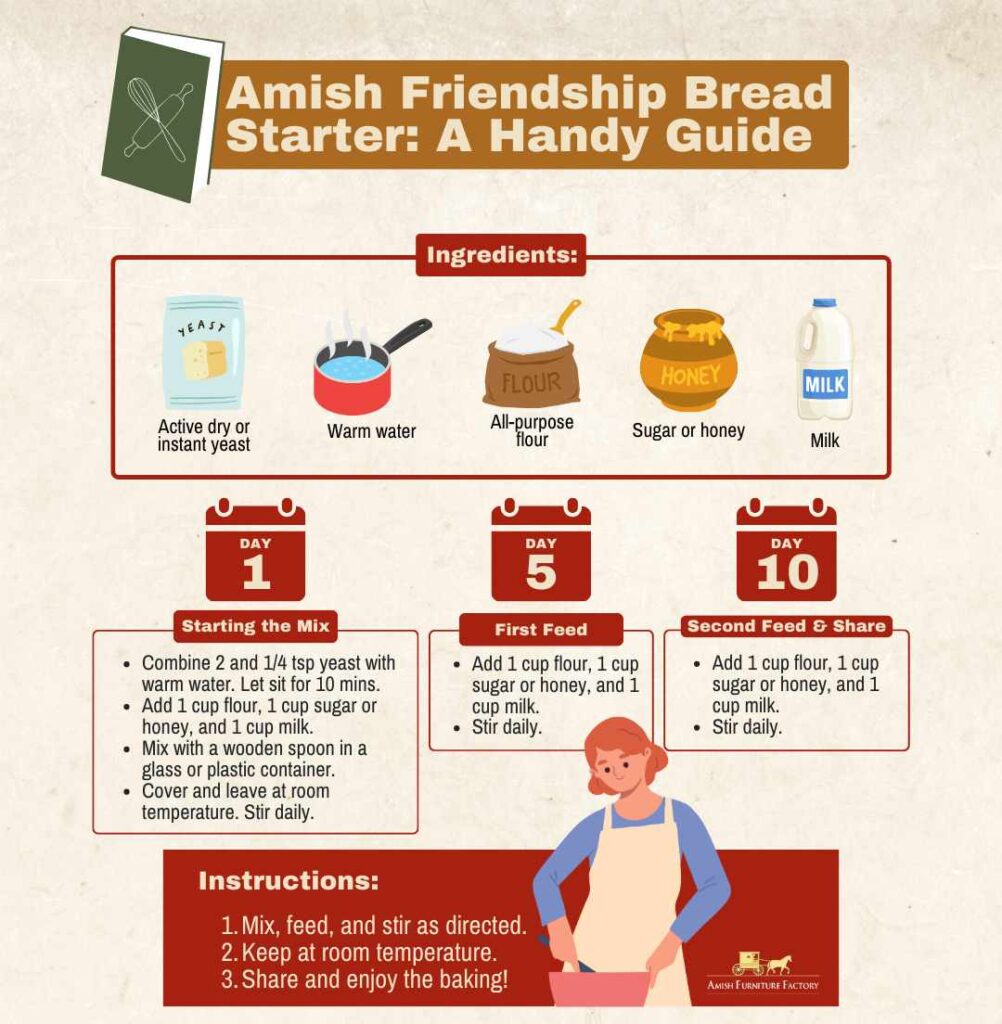
Throughout the 10-day cycle, checking the starter’s smell occasionally is important. It should have a yeasty, beer-like aroma. If it develops a sharp smell and you last fed it five days ago, it’s time to feed it. After feeding, smell it again in 48 hours to see if the scent has improved.
You can refrigerate the starter if you want to slow down the process. For starters that have been frozen, treat them as if it’s day one once they’re thawed. Keep any unused starter in the freezer to maintain its quality.
Tips for Maintaining and Sharing the Starter
The appeal of Amish Friendship Bread lies not only in its delicious taste but also in the ongoing tradition of sharing it. Here are some tips to help your starter thrive and keep this wonderful tradition going:
- – Use a non-reactive container, such as glass or ceramic, with a loose lid for your Amish Friendship Bread starter to prevent fermentation problems. A container that holds at least 2 quarts is ideal to give your starter enough space to expand without overflowing.
- – It’s essential to feed your starter regularly. Mix equal amounts of flour, sugar, and milk daily, using one cup each for every starter. If feeding it daily is too much, you can do it every other day, but only go as long as that to keep your starter strong.
- – The best temperature for your starter to thrive is between 70-80°F (21-27°C). Avoid drafts and direct sunlight. Placing it on your kitchen counter, especially close to the oven, can offer a consistently warm setting.
- – Stir gently with a wooden spoon, gently mixing the new ingredients into the existing starter. It’s okay if there are some lumps; they will disappear as fermentation continues.
An excellent tip for sharing your Amish Friendship Bread starter is to include a small container with a lid and a measuring spoon when gifting it. This thoughtful addition makes it easier for your friends and family to start their baking journey with the Amish Friendship Bread.
Here’s a helpful video showing you how to make an Amish Friendship Bread starter.
The Amish Friendship Bread Recipe
The starter is the heart of this Amish bread, so the whole procedure is a handful. However, this Amish bread is worth all the time and effort it takes.
The Ingredients:
- 1 cup Amish bread starter
- 1 cup vegetable oil
- 1 cup powdered sugar
- 3 eggs
- ½ teaspoon pure vanilla extract
- 1 ½ teaspoon baking powder
- ½ teaspoon baking soda
- ½ teaspoon salt
- 2 teaspoons cinnamon sugar
- 2 cups all-purpose flour
Note: If your Amish Bread starter is frozen, do not thaw all of it at once.
The Process:
- Preheat the oven to 325°F.
- Grease and set aside two loaf pans.
- Mix the starter, vegetable oil, powdered sugar, eggs, and vanilla extract in a glass bowl.
- Mix the baking powder, soda, salt, flour, and cinnamon sugar in a separate bowl.
- Pour the liquid mixture into the dry ingredients and stir to combine.
- Evenly distribute half of the batter between the two greased loaf pans, using one-fourth of the total batter for each pan.
- Mix an equal amount of powdered sugar and cinnamon in a separate bowl. Sprinkle half on top of the batter. Fill each loaf pan with the remaining batter and sprinkle the rest of the combined sugars on top.
- Bake for 40 to 50 minutes. Keep the oven door closed at all times. A sudden drop in temperature may cause your bread dough to collapse in the middle.
- Test the bread dough with a toothpick after 50 minutes. If it comes out clean, your Amish Friendship Bread is ready.
- Allow it to cool.
- You can customize your Amish Friendship Bread to suit your preferences, especially if you want a dessert or a sweet snack. Feel free to add chocolate chips, raisins, diced apples, or any other favorite ingredients into the mix before baking.
Please note that before you add anything on top of the batter, sprinkle one tablespoon of all-purpose flour first to prevent your mix-ins from sinking.
The Amish Friendship Bread Recipe Without A Starter
The good news is that you can bake Amish Friendship Bread even without a starter. It may not turn out as good as the Amish bread with a starter, but this recipe is also great if you’re craving a nice homemade bread to proudly share with your family and guests.
To bake this Amish homemade bread without a starter, you will need the following ingredients:
- 1 cup vegetable oil
- 1 1/2 cups buttermilk
- 3 eggs
- 1 cup powdered sugar
- ½ teaspoon pure vanilla extract
- 2 teaspoons cinnamon sugar
- 1 ½ teaspoon baking powder
- ½ teaspoon salt
- ½ teaspoon baking soda
- 2 cups all-purpose flour
The Steps:
- Preheat the oven to 325° F.
- Mix the vegetable oil, buttermilk, eggs, pure vanilla extract, baking powder, salt, baking soda, and all-purpose flour in a large mixing bowl.
- Mix 1 cup sugar and 1 teaspoon cinnamon sugar in a smaller bowl.
- Grease and dust two large loaf pans with 1/2 of the sugar mix.
- Pour the batter evenly into the two pans.
- Sprinkle the remaining sugar on top.
- You may also add chocolate chips, raisins, or just about anything on the lightly floured surface of the batter.
- Bake for at least 60 minutes.
- Test the bread dough with a toothpick. Your freshly baked Amish Friendship Bread is ready if it comes out clean.
- Cool completely before slicing.
Here’s a great video showcasing an Amish Friendship Bread with no starter required:
Is Amish Friendship Bread a Healthy Choice?
Amish Friendship Bread is sweeter and less tangy compared to sourdough, which has a lower glycemic index and impacts blood sugar levels more gradually than regular white bread.
The fermentation process in sourdough (and Amish Friendship Bread) offers some potential health benefits. Fermented foods can be easier to digest; some studies suggest they may improve gut health.
But overall, is it healthy?
As for whether Amish Friendship Bread is healthy, it depends on your definition of “healthy” and your dietary needs. Here are some points to consider:
Sugar Content: Amish Friendship Bread is quite high in sugar from added sugars and those in the pudding mix and potential add-ins like fruits. High sugar intake can be a concern for those managing blood sugar levels or looking to reduce caloric intake.
Nutrients: The bread provides basic nutrients from ingredients like eggs and milk, such as protein, vitamins, and minerals. However, these nutrients are not particularly high compared to other food choices that could be part of a balanced meal.
Processed Ingredients: The use of processed ingredients like instant pudding mix adds artificial flavors and potentially other additives that might not be desirable for a health-focused diet.
Calories: It’s relatively calorie-dense due to the sugar, fats, and refined flour. If you’re watching your calorie intake for weight management or other health reasons, you might want to consume it in moderation.
Whole Grains and Fats: The traditional recipe uses refined flour and can include a significant amount of fat from oil and eggs. Using whole grain flour or substituting some of the oil with applesauce could make it healthier.
While Amish Friendship Bread can have some benefits due to fermentation, it’s important to remember that the high sugar content makes it more of an occasional treat than a health food. Enjoy Amish Friendship Bread for its unique flavor and tradition, but as with any sweet treat, consume it in moderation as part of a balanced diet.
Newer Variations and Modern Twists
The appeal of Amish Friendship Bread lies in its simplicity and the room it offers for creativity. Over time, bakers have added their personal touches to the original recipe, creating many tasty variations.
Here are some creative ideas to personalize this classic favorite:
Fruity Delights: You can mix in chopped apples, pears, cherries, cranberries, or a combination of your favorites. For a citrus flavor, add orange or lemon zest. If you’re using dried fruits, soak them in warm water or fruit juice for about 15 minutes before mixing them into the batter.
Spice Things Up: Cinnamon, nutmeg, and ginger go really well with the sweet taste of Amish Friendship Bread. If you’re looking for something different, add a bit of cardamom, allspice, or even a little cayenne pepper for an unexpected spicy flavor.
Chocolate Cravings: Adding cocoa powder or melted chocolate chips to the batter creates a rich and decadent variation. Try swirling in some Nutella or peanut butter before baking for an extra layer of flavor.
Going Nuts: Adding chopped nuts such as almonds, walnuts, pecans, or macadamia nuts can give Amish Friendship Bread a nice texture contrast. Toasting the nuts before adding them can also enhance the bread’s flavor.
Boozy Twists: Adding a bit of your favorite liqueur, rum, or bourbon can give the bread a sophisticated touch. Start with a tablespoon and adjust to taste. Remember, alcohol can affect the bread’s rise, so be careful with the amount you use.
Modern Makeovers: The Amish Friendship Bread batter can be used for various treats. Try making muffins, cupcakes, or even cinnamon rolls. For a fun presentation, consider baking the batter in a mini bundt cake pan for adorable individual portions.
How to Store Amish Friendship Bread After Baking
You don’t need to refrigerate Amish Friendship Bread right after baking. Store it at room temperature in an airtight container for a few days, just like other baked goods.
If you won’t eat all the bread within that time, wrap it well and freeze it. For convenience, you can slice the bread before freezing, allowing you to enjoy a piece at a time.
To warm up your bread:
- – Heat it in the oven at 350°F for 10 minutes.
- – You may add melted butter and a sprinkle of brown sugar on top.
Conclusion
The Amish Friendship Bread is more than just a recipe; it’s a testament to the values of simplicity, generosity, and community spirit that define the Amish way of life.
This tradition started with a simple sourdough recipe and has grown to include many unique versions. Each step shows the Amish community’s values and commitment to peacefully living together.
This bread does more than fill the stomach; it warms the heart and brings people together, making it an enduring symbol of friendship and togetherness. Whether you’re a seasoned baker or new to the kitchen, Amish Friendship Bread offers a chance to partake in a tradition beyond the kitchen, extending a hand of friendship and a slice of comfort to those around you.
Frequently Asked Questions (FAQ)
1. Why can’t you use metal with Amish Friendship Bread?
Metal containers can disrupt the Amish Friendship Bread starter’s fermentation, reacting with acids and possibly changing its flavor and texture. It’s better to use non-reactive containers like glass, ceramic, or food-grade plastic for the best outcome.
2. How long can you keep an Amish Friendship Bread Starter?
If you take good care of it and feed it well, an Amish Friendship Bread starter can last forever! The most important thing is to be consistent. Feeding it regularly, either everyday or every other day, with equal amounts of flour, sugar, and milk, will keep your starter healthy and active, allowing you to bake with it for many years.
3. Is Amish Friendship Bread the same as sourdough?
Amish Friendship Bread and sourdough bread both use a fermented starter for leavening. Yet, they differ in some ways. Sourdough starters are made with just flour and water, but Amish Friendship Bread starters also include sugar and milk with the flour. This makes Amish Friendship Bread sweeter and a bit tangier, unlike the classic sour taste of sourdough bread.
